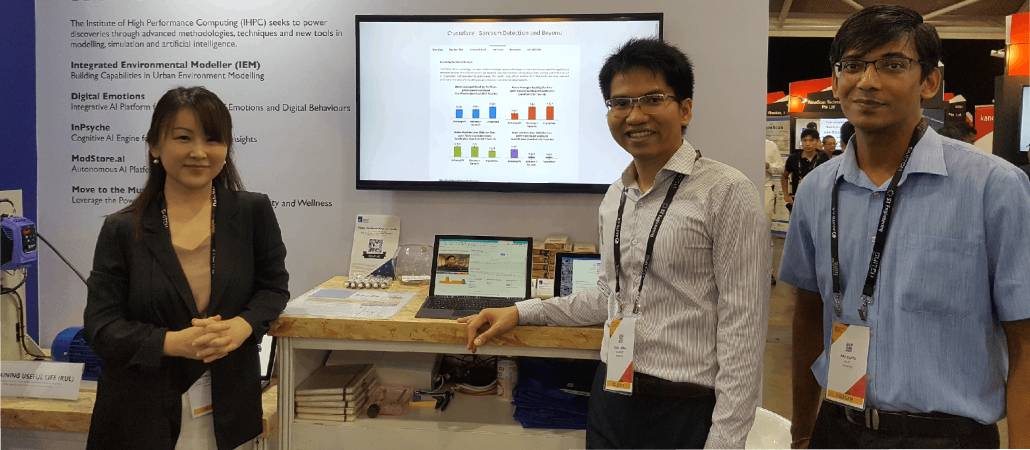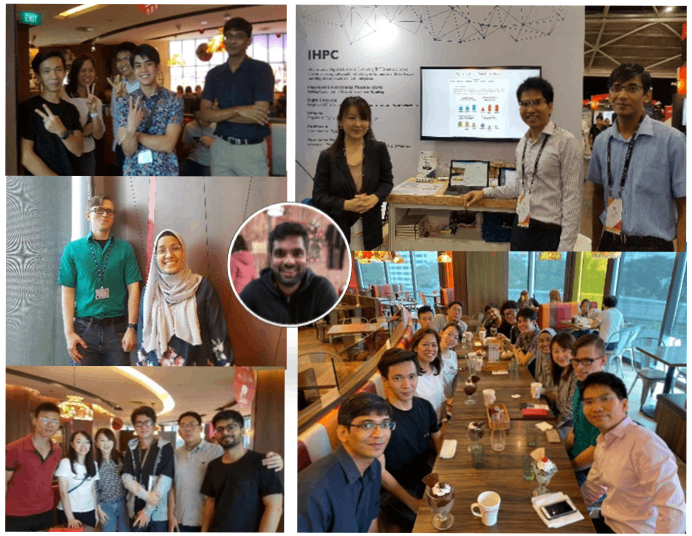FACES OF A*STAR
Women in Science: Dr Yang Yinping, IHPC
The 'Women in Science' series aims to break down gender inequalities and celebrates the achievements of our female scientists and researchers in A*STAR. Hear their stories and discover how their unique personal lives and perspectives shape the great work they do.
Read on to find out how research by Dr Yang Yinping and her team into deep social technologies – in particular their multidimensional emotion analytic engines - has been helpful for the economic, industry, and societal applications, including insights into population responses to the COVID-19 pandemic.
Dr Yang Yinping, A*STAR Senior Scientist & Group Manager, Institute of High Performance Computing (IHPC)

Dr Yang and her two colleagues at the SWITCH x SFF 2019 event held in October 2019, from left: Dr Yang Yinping, Dr Tuan Le Mau (Scientist at IHPC), and Dr Raj Kumar Gupta (Senior Scientist at IHPC).
Q: Tell us what you do at A*STAR.
As a social technologist, I am passionate about advancing human communication and decision-making by building useful technologies.
When I joined A*STAR's Institute of High Performance Computing (IHPC) in 2007, my first research experience was to build an intelligent e-negotiation agent. This was followed by research into sentiment analysis and emotion recognition. I am currently the group manager of the Affective Computing Group and the principal investigator driving A*STAR’s Digital Emotion and Empathy Machine programme. I also act as an advisor to tech start-ups in emotion analytics and e-negotiation systems.
As a founding member and senior scientist at IHPC’s Social and Cognitive Computing Department since 2014, I founded, built and currently lead a multidisciplinary team of scientists and engineers across diverse backgrounds, including computer science, software engineering, information systems, psychology, linguistics, communication and even, media arts.
Q: What are your motivations for getting into this field of social intelligence and affective computing research?
A key motivation is to advance the social science inquiry to analyse, understand, and ultimately enhance human communications in the digital era.
I am fortunate to have background training in both computer science and social and behavioral sciences. Social science theories and principles are beneficial for technologists to appreciate the what, why and how of human behaviors. Having hands-on experiences in using multiple social science research methods, including experiments, surveys and case studies, broadened my horizon and deepened my appreciation of the complexity of human nature and behaviors.
Social science research conventionally relies on respondents' reactions through questionnaires or an interview. I subscribe to the paradigm shift that social sciences research needs to take a more “naturalistic inquiry” approach, by studying people in their natural settings. Using “naturalistic inquiry” would require tools that can meaningfully and unobtrusively measure psychological constructs that allow studying people, their thoughts, feelings, opinions and desires, in more naturalist settings as and when things unfold.
A second motivation is to capture the variability of emotional intensity, as the "depth” or intensity of our emotions varies from one experience to another. This can range from feeling afraid about missing a bus, losing a loved one to a deadly disease, to feeling moderately scared but simultaneously very joyful when watching horror movies.
In sentiment analysis and emotion recognition, researchers predominantly consider sentiments or emotions as discrete classes. For example, sentiment is typically classified as positive, negative or neutral; and emotion is either happy or unhappy, sad or not sad, angry or not angry. While emotional intensity is a salient aspect of our emotional experience, it is ironically one of the most ignored concepts, largely due to its complexity.
A third motivation is to decode highly complex communications with mixed-motives and conflicting cues, such as mistrustful negotiations and sarcastic expressions.
Q: What is CrystalFeel? Tell us more about you and your team’s involvement in this project.
CrystalFeel is an emotion analytic engine my team has been developing since 2016, and my key research collaborator and co-inventor is Dr Raj Kumar Gupta, an expert in machine learning and software systems.
CrystalFeel has been applied in a few empirical studies, and is now used on our larger social media analytic platforms, including the COVID-19 social listening system. CrystalFeel focuses on analysing text to determine the level of multidimensional emotional intensity.
This software consists of five pre-trained algorithms that analyses the emotional intensity in a short text message based on five psychologically meaningful dimensions. The five dimensions include fear intensity, anger intensity, happiness intensity, sadness intensity, the overall emotional valence intensity. The system also provides outputs on categorical labels in sentiment and emotion categories to facilitate interpretation.
A demo video on how CrystalFeel works
Q: Could you share with us some recent projects related to CrystalFeel?
While CrystalFeel is accurate, rich and psychologically meaningful, we are conscious that the technology as a core emotion analytic engine can only directly benefit tech-savvy users.
Recently, we developed an end-to-end social listening platform that integrates CrystalFeel with data acquisition and programmatic access to multiple important data source platforms and an intuitive and interactive user interface.
We named our new platform Resonance Social, intending to democratize social analytics and empower all potential users – not just tech-savvy data scientists, but also market analysts, communication professionals, news editors and even C-Suite executives – to effectively listen to the ground’s voices in response to their services, their products, and their organisations. We hope Resonance Social can be a bridge to help our users manage big social data and make an emotional level connection with their audience and their stakeholders with timely and accurate sensing of the ground.
Q: What is your team’s biggest achievement to date?
Our work over the past five years has led to a few economic, industry and societal applications. To me, there is no single achievement that is too big or small – it’s a matter of whether it is salient enough to meet the needs of different stakeholders.

One recent achievement that we are proud of is the deployment of a large-scale, multisource social listening system to understand the general population's responses to the COVID-19 pandemic. Going live as early as 7 February 2020, the Twitter-based global emotion trend analysis dashboard that we call Heartbeat for COVID-19, tracks the public emotions across temporal and geographic distributions. To date, our system has collected and processed close to 100 million tweets surrounding the mentions of “corona”, “wuhan”, “nCov”, and “covid”.
The data and analysis provide a valuable source of insights to enable studies to analyse the public response to the pandemic. By working with public health professionals and communication scientists, we see that the results and findings provide valuable insights to inform decisions surrounding public policies, policy adjustments and operational resources allocation.
Q: Your team's favourite hang-out spot.
Slack and Zoom.
Was this article helpful?
A*STAR celebrates International Women's Day

From groundbreaking discoveries to cutting-edge research, our researchers are empowering the next generation of female science, technology, engineering and mathematics (STEM) leaders.
Get inspired by our #WomeninSTEM
